Disclaimer:
- my code might look slightly over-engineered
- for someone doing lots of CP stuff recently, the available set of constraints of this library look strange and/or incomplete (compared to industrial-strength Gecode)
- i consider this solution a hack (but it's enough for this toy-problem)
- i kept most of your code, but changed the spaces to numbers (8, 9) for better visualization
Basic idea
Assuming the dimensions are fixed a-priori, there are exactly 5 valid cases for the constraint you seek, when looking from the front of the slice:
0: _ __ TARGET ...dontcare
1: __ _ TARGET ...dontcare
2: _ TARGET ...dontcare
3: __ TARGET ...dontcare
4: TARGET ...dontcare
As someone coming from SAT-solving (before CP), i feel reasoning with clauses pretty natural. The above is easily expressed in boolean-logic (not same order as above):
( pos0 = F )
OR ( (pos0 = _ ) and (pos1 = F) )
OR ( (pos0 = __) and (pos1 = F) )
OR ( (pos0 = __) and (pos1 = _ ) and (pos2 = F)
OR ( (pos0 = _ ) and (pos1 = __ ) and (pos2 = F)
Normally one would use a well-implemented constraint / propagator (using SAT technology), but this library is missing the usual stuff.
But to our rescue: there is FunctionConstraint which allows us to build a simple propagator. This is actually quite a nice design (for small and relatively easy problems)!
Some remarks:
clause builds our boolean-logic based propagator (in non-efficient manner)row and clause returns the 1d-indices based on what we wantreverse let's us reuse the logic when the constraint needs to act from the end (and not on the front)- we use partial function application to make the calls compact
- numpy is just used as quick visualization-tool (there is nothing worse than reasoning about matrix-solutions from a dict)
Code
""" ORIGINAL CODE """
from constraint import *
problem = Problem(BacktrackingSolver())
variables = []
for i in range(0, 25):
variables.append(i)
domain= []
for i in range(1,4):
domain.append(i)
domain.append(8)
domain.append(9)
problem.addVariables(variables, domain)
for row in range(5):
problem.addConstraint(AllDifferentConstraint(), [row * 5 + i for i in range(5)])
for col in range(5):
problem.addConstraint(AllDifferentConstraint(), [col * 5 + i for i in range(5)])
""" ADDITIONS """
from functools import partial
def clause(target, p0, p1, p2, p3, p4):
wildcards = [8, 9]
return (p0 == target) or \
( (p0 in wildcards) and (p1 == target) ) or \
( (p0 in wildcards) and (p1 in wildcards) and p2 == target )
row = lambda x: [x * 5 + i for i in range(5)]
col = lambda x: [x + i * 5 for i in range(5)]
reverse = lambda x: list(reversed(x))
problem.addConstraint(partial(clause, 3), reverse(row(0))) # C
problem.addConstraint(partial(clause, 2), reverse(row(1))) # B
problem.addConstraint(partial(clause, 3), reverse(row(2))) # C
problem.addConstraint(partial(clause, 1), row(2)) # A
problem.addConstraint(partial(clause, 2), row(3)) # B
problem.addConstraint(partial(clause, 1), col(0)) # A
problem.addConstraint(partial(clause, 2), col(1)) # B
problem.addConstraint(partial(clause, 1), col(3)) # A
problem.addConstraint(partial(clause, 3), reverse(col(0))) # C
problem.addConstraint(partial(clause, 3), reverse(col(2))) # C
problem.addConstraint(partial(clause, 3), reverse(col(3))) # C
""" SOLVE """
solution = problem.getSolution()
print(solution)
""" VISUALIZE """
import numpy as np
matrix = np.zeros((5, 5), dtype=int)
matrix[np.unravel_index(range(5*5), (5,5))] = [solution[i] for i in range(5*5)]
print(matrix)
Output
λ python C:\Tmp\constr.py
{10: 9, 13: 3, 11: 1, 12: 2, 0: 9, 3: 1, 5: 1, 8: 2, 15: 9, 18: 8, 14: 8, 20: 3, 23: 9, 1: 2, 2: 8, 6: 9, 7: 3, 16: 2, 17: 3, 4: 3, 9: 8, 19: 1, 22: 8, 21: 2, 24: 1}
[[9 2 8 1 3]
[1 9 3 2 8]
[9 1 2 3 8]
[9 2 3 8 1]
[3 2 8 9 1]]
The result surprisingly looks correct ;-), comparing with your original task:

